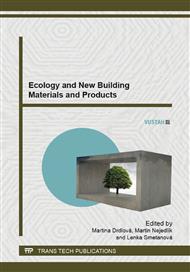p.47
p.51
p.55
p.59
p.63
p.67
p.73
p.77
p.81
Laboratory Preparation of a Ternary Binder System
Abstract:
Currently, the binders of self-levelling mixtures are most commonly implemented as one-component or two-component (binary) systems. One-component systems are usually Portland cement or alumina cement alone, both further modified especially by plasticizers and dispersive additives. In addition to their indisputable advantages, one-component as well as binary systems have some drawbacks including worse technological properties in the case of one-component systems based on Portland cement and higher financial costs in the case of binary systems which are usually mixtures of anhydrite II and α-gypsum. These deficiencies should be addressed by a ternary system which represents a compromise between the quality and affordability of existing systems. The basis of this ternary system is Portland cement to which an expansion agent composed of alumina cement and gypsum or dry hydrate is added. In this system, it is expected that the required strength and volume stability will be provided by Portland cement and the expander, respectively. The aim of this work is to study the ternary binder system based on Portland cement, alumina cement and gypsum or supplementary non-traditional connective components for use in the industrial production of self-levelling mixtures.
Info:
Periodical:
Pages:
63-66
Citation:
Online since:
August 2014
Keywords:
Price:
Сopyright:
© 2014 Trans Tech Publications Ltd. All Rights Reserved
Share:
Citation:


